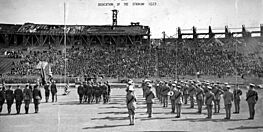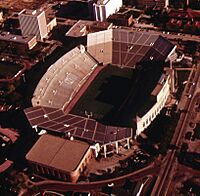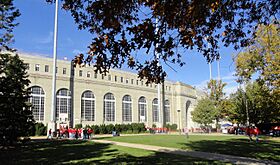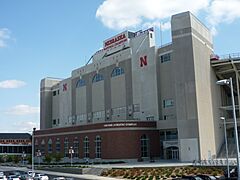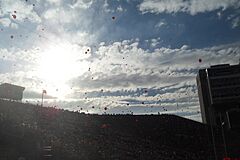Memorial Stadium (Lincoln) facts for kids
|
"The Sea of Red"
|
|
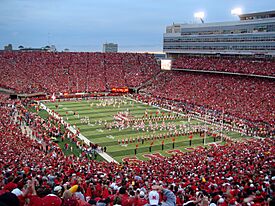
Memorial Stadium in 2007
|
|
| Full name | Tom Osborne Field at Memorial Stadium |
|---|---|
| Address | 600 Stadium Drive Lincoln, Nebraska, U. S. |
| Elevation | 1,150 feet (350 m) |
| Owner | University of Nebraska–Lincoln |
| Operator | University of Nebraska–Lincoln |
| Type | Stadium |
| Capacity | 85,458 (2017–present)
List
|
| Record attendance | 92,003 (volleyball – Aug. 30, 2023) 91,585 (football – Sep. 20, 2014) |
| Surface | FieldTurf (1999–present) AstroTurf (1970–1998) Natural grass (1923–1969) |
| Construction | |
| Broke ground | April 26, 1923 |
| Opened | October 13, 1923 (102 years ago) |
| Renovated | 1967, 1994, 2000, 2026 (planned) |
| Expanded | 1964, 1965, 1966, 1972, 1999, 2006, 2013 |
| Construction cost | $482,939 (original structure) ($8.29 million in 2022 ) |
| Architect | John Latenser Sr. Ellery L. Davis |
| Project manager | Earl Hawkins |
| Structural engineer | Meyer & Jolly |
| General contractor | Parsons Construction |
| Tenants | |
| Nebraska Cornhuskers football (NCAA / FBS) (1923–present) |
|
Memorial Stadium, often called "The Sea of Red," is a famous American football stadium. It is located on the campus of the University of Nebraska–Lincoln in Lincoln, Nebraska. This stadium is mainly the home field for the Nebraska Cornhuskers football team. It also hosts the university's graduation ceremonies each spring.
The university started planning a new stadium after World War I. They needed to replace Nebraska Field, which was too old and small. After raising money and changing designs, construction began in mid-1923. Memorial Stadium opened on October 13, 1923, even though it was not fully finished. It was built to honor Nebraskans who served in the American Civil War, the Spanish–American War, and World War I.
The stadium first had grandstands along its east and west sides. It could hold 31,080 people. Over the years, major expansions between 1999 and 2013 increased its size to 85,458 seats. These changes completely surrounded the original building, which is still mostly there. In the past, over 90,000 fans often attended games.
Nebraska has sold out 403 games in a row at Memorial Stadium. This is an amazing record for any sport in the NCAA, going all the way back to 1962. In 2023, Memorial Stadium hosted Volleyball Day in Nebraska. A record 92,003 people attended, making it the largest crowd ever for a women's sports event. Memorial Stadium is known as one of the best places to watch college football.
Contents
Building Memorial Stadium
In 1909, the University of Nebraska built Nebraska Field. This was their first permanent football field in downtown Lincoln. But its wooden seats and small size meant a bigger, stronger stadium was soon needed. Plans were delayed by American entry into World War I. However, after the war ended in 1918, the university started planning a new stadium at the same spot.
College football became very popular after the war. Many people wanted the new stadium to honor Roscoe Rhodes, a former team captain who died in France in 1918. The Nebraska Memorial Association was created to raise money for the "Nebraska Soldiers and Sailors Memorial." This big project included a stadium, a gym, a museum, and special areas for veterans.
The state set aside $250,000 for the project. Students and teachers also raised $150,000. They were encouraged to give as much as they could. Famous alumni like John J. Pershing, a top general, and Cy Sherman, a sportswriter, also helped.
A farming crisis in the early 1920s caused the state to pull back its funding. Many parts of the stadium plan had to be made smaller or removed. John Latenser Sr. and Ellery L. Davis became the main architects. They worked for free, which was a big help.
Construction officially started on April 23, 1923. The cost ended up being higher than expected. The Memorial Association had to take out a large loan. Finally, Parsons Construction Company was hired for $482,939.
The stadium had to be ready for the 1923 football season. Workers included university students and future football players. Despite a rainy summer and a tornado, the stadium was mostly ready for the first game. On October 13, Nebraska played Oklahoma and won 24–0. The game was played on dirt because the grass field was not yet installed. A week later, the stadium was officially named "Memorial Stadium." It honored Nebraskans who served in the American Civil War, the Spanish–American War, and World War I.
The stadium was built facing north-to-south. It had open areas at the ends and grandstands along the sides. A running track went around the field. Each corner of the stadium has a special message from a philosophy professor named Hartley Burr Alexander:
- Southeast: "In commemoration of the men of Nebraska who served and fell in the nations wars."
- Southwest: "Not the victory but the action; not the goal but the game; in the deed the glory."
- Northwest: "Courage; generosity; fairness; honor; in these are the true awards of manly sport."
- Northeast: "Their lives they held their country's trust; they kept its faith; they died its heroes."
Stadium Expansions
Memorial Stadium grew bigger over the years. The first major expansion was in 1964. Permanent seats were added to the south end zone, making the stadium a horseshoe shape with 44,829 seats. The north end zone was enclosed in 1965 and 1966, bringing the capacity to 62,644. This was more than double its original size. A new press box was built in 1967. This project was paid for by selling VIP seats for the first time. The south end zone was expanded again in 1972, increasing capacity to 73,650.
In the early 1980s, temporary lights were sometimes used for late afternoon games. The first night game at Memorial Stadium was on September 6, 1986. Nebraska beat Florida State 34–17. Permanent lights were not installed until 1999.
In 1993, a section of seats collapsed into a tunnel. Luckily, no one was hurt. This section was designed to be removable for track meets. After this, the university started checking the stadium's structure more often.
The playing field was named "Tom Osborne Field" in 1998. This happened after Osborne retired as coach. The next year, Nebraska finished a $36-million expansion of West Stadium. This added a new press box and a large concrete front facing Stadium Drive. The north end zone was updated and expanded in 2006. This added six thousand seats and thirteen luxury boxes, raising capacity to 81,067.
In 2010, fans were asked about a planned East Stadium project. The most popular idea was to add more seats to keep Nebraska's sellout streak going. This $65-million project was finished in 2013. It added over six thousand new seats, bringing the capacity to 87,147. It also included the stadium's first standing-room-only section. Two large research facilities were also built. The original East Stadium structure was kept inside a new entrance lobby. A statue of former coach Bob Devaney was placed in front.
Since 2013, Memorial Stadium has had smaller updates to make fans more comfortable. A public Wi-Fi network and extra video screens were added. Bleacher seats were made wider in some areas, which slightly reduced the capacity to 85,458. A brick design was added to the base of West Stadium to match the rest of the building.
In 2023, Nebraska announced plans to rebuild South Stadium. This part of the stadium has never had a big renovation. The project would create a full circle concourse for fans to walk around. It would also reduce seating capacity because benches would be replaced with larger, more comfortable chair-back seats. The cost was estimated at $450 million. Half of the money would come from the university and half from private donations. The project is still being reviewed.
Seating Capacity Changes
- 1923: 31,080
- 1964: 44,829 – South end zone seats added.
- 1965: 50,807 – Center of north end zone seats added.
- 1966: 62,644 – North stadium seats finished.
- 1967: 64,170 – New press box and special suites.
- 1972: 73,650 – South end zone seats extended.
- 1994: 72,700 – Seats for people with disabilities installed.
- 1999: 74,056 – New West Stadium press box, skyboxes, and club seating.
- 2000: 73,918 – More club seating added.
- 2006: 81,067 – North Stadium seats extended, more skyboxes and handicap seating.
- 2013: 87,147 – East Stadium expanded.
- 2015: 86,047 – North end zone seats widened, some seats removed.
- 2017: 85,458 – Seats widened throughout the stadium.
Other Facilities at the Stadium
Memorial Stadium stayed mostly the same for over ten years after it opened. In the mid-1930s, the university planned more buildings near the north end zone. But money problems during the Great Depression made it hard to get the land. Digging for a football facility started in 1939, with help from the Work Projects Administration. The building was partly finished when World War II stopped progress. However, the locker rooms could still be used.
The Schulte Fieldhouse was completed in 1949. It had a large clock overlooking the north end zone, one of the first game clocks for fans in college football. The building was named after former coach Henry Schulte. This fieldhouse was used until 2004. It was then torn down to make way for the Osborne Athletic Complex. This new $50-million building has locker rooms, training areas, and offices. A statue of coach Osborne and Brook Berringer, a former quarterback who died in a plane crash, was placed at the entrance.
Just ten years after the Osborne Athletic Complex was built, Nebraska's football facilities needed more updates. In 2024, the university finished the Osborne Legacy Complex. This huge $165-million facility is just northeast of Memorial Stadium. Most of the athletic operations moved to this new building.
Playing Field Surface
The first game at Memorial Stadium was played on dirt because the grass field was not ready. Nebraska played on natural grass until 1970. Then, the stadium got AstroTurf. This was an artificial turf surface that was glued to a foam layer on a bed of asphalt. It became famous after being used in the Houston Astrodome. The AstroTurf project cost $250,000. It was part of coach Bob Devaney's plan to improve sports facilities.
Several types of AstroTurf were used at Memorial Stadium until 1999. Then, Nebraska became the first major college football team to install FieldTurf. This is a lighter, synthetic surface designed to feel more like natural grass. The FieldTurf has been replaced three times. Sometimes it has a pattern of light and dark green every five yards. The university plans to return to a natural grass field at Memorial Stadium, possibly by 2026.
- 1923–1969: Natural grass
- 1970–1983: AstroTurf
- 1984–1991: All-Pro Turf
- 1992–1998: AstroTurf-9
- 1999–present: FieldTurf
- 2026 (planned): Natural grass
Stadium Traditions
Since 1993, Nebraska's home games start with the "Tunnel Walk." The team runs onto the field before kickoff, usually to the song "Sirius." The team used to come out from the southwest corner. This changed to the northwest corner in 2006, and then to the northeast corner in 2023. Before the Tunnel Walk, fans do a "Husker Power" chant. Half the stadium shouts "Husker" and the other half shouts "Power."
Fans at Memorial Stadium have released red helium balloons when Nebraska scores its first points since the 1960s. This tradition was even seen as early as 1932. However, global helium shortages and environmental worries have sometimes stopped this tradition. It was paused in 2012 and 2022.
Another tradition is that the crowd at Memorial Stadium often claps for the visiting team when they leave the field. This happens no matter who won the game.
Attendance Records
Nebraska has sold out 403 games in a row at Memorial Stadium. This is an NCAA record for any sport, dating back to 1962. Nebraska's football team was very strong at Memorial Stadium for many years. They even had a forty-seven-game home winning streak from 1991 to 1998. This is one of the longest in college football history. The sellout streak is a source of pride for the team and its fans. During this streak, Nebraska's record is 326 wins and 77 losses.
Most of the stadium's highest attendance records were set after the East Stadium expansion in 2013. The capacity was slightly reduced in 2015 when some seats were made wider. The largest non-sports event at Memorial Stadium was a Garth Brooks concert on August 14, 2021. Nearly 90,000 people attended.
Memorial Stadium has hosted ESPN College GameDay seven times. In 2001, Nebraska set a GameDay attendance record that lasted for nine years. Nebraska's student section is called "The Boneyard." It is located in the southeast corner of East and South Stadium.
| No. | Attendance | Date | Winning team | Losing team | Event type | ||
|---|---|---|---|---|---|---|---|
| 1 | 92,003 | Aug. 30, 2023 | No. 4 Nebraska | 3 | Omaha | 0 | College volleyball |
| 2 | 91,585 | Sept. 20, 2014 | No. 24 Nebraska | 41 | Miami (FL) | 31 | College football |
| 3 | 91,471 | Sept. 14, 2013 | No. 16 UCLA | 41 | No. 23 Nebraska | 21 | |
| 4 | 91,441 | Aug. 30, 2014 | No. 22 Nebraska | 55 | FAU | 7 | |
| 5 | 91,414 | Sept. 17, 2016 | Nebraska | 35 | No. 22 Oregon | 32 | |
| 6 | 91,255 | Sept. 27, 2014 | No. 21 Nebraska | 45 | Illinois | 14 | |
| 7 | 91,186 | Nov. 22, 2014 | Minnesota | 28 | No. 21 Nebraska | 24 | |
| 8 | 91,185 | Aug. 31, 2013 | No. 18 Nebraska | 37 | Wyoming | 34 | |
| 9 | 91,140 | Nov. 2, 2013 | Nebraska | 27 | Northwestern | 24 | |
| 10 | 91,107 | Nov. 1, 2014 | No. 17 Nebraska | 35 | Purdue | 14 | |
Other Events at the Stadium
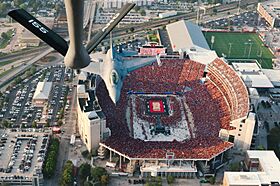
High School Football
Since 1996, Memorial Stadium has hosted most of the Nebraska School Activities Association's high school football state championship games. This includes games for smaller schools that play eight-man football. Before moving to Memorial Stadium, these final games were played at one of the schools competing.
Nebraska plans to install a natural grass field, possibly by 2026. After that, Memorial Stadium will only host high school state football games for two days.
Volleyball Events
On August 30, 2023, Memorial Stadium hosted Volleyball Day in Nebraska. This event included two games with teams from the University of Nebraska system. Division II Nebraska–Kearney played Wayne State. Then, Nebraska defeated Omaha. A crowd of 92,003 people watched. This was the largest attendance ever recorded for a women's sporting event.
The volleyball court was set up on the north side of the football field. Tickets were sold for seats all over the stadium. Adding field-level tickets helped the event set a new attendance record for Memorial Stadium.
Concerts and Shows
Memorial Stadium has not hosted many non-sports events in the past. However, the university is interested in using the venue more often throughout the year.
Memorial Stadium hosted Farm Aid III on September 19, 1987. This was just days after a big football game. The ten-hour event featured famous musicians like John Mellencamp, Willie Nelson, and Neil Young. Other performers included John Denver and Joe Walsh. Over 60,000 people attended, and it raised $1.7 million to help farmers during a difficult time.
Comedian Dan Whitney, known as Larry the Cable Guy, recorded his 2009 album Tailgate Party at Memorial Stadium. He performed in front of 52,000 fans.
Country music star Garth Brooks performed at Memorial Stadium in 2021. This event was a test to see if the stadium could sell alcohol. Nebraska approved selling beer at football games in 2025. Scotty McCreery performed after Volleyball Day in Nebraska on August 30, 2023. He said it was the biggest crowd he had ever played for. McCreery's performance was even featured in his music video for "Cab in a Solo."
See also
 In Spanish: Memorial Stadium (Lincoln) para niños
In Spanish: Memorial Stadium (Lincoln) para niños


